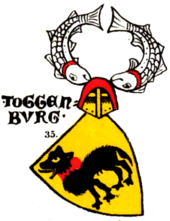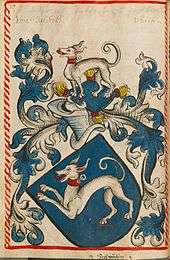Hound (heraldry)
The hound or dog (also levrier, leverer; French lévrier;[1] dogue, chien) is used as a charge in classical heraldry. In English heraldry, the commonly used variant are the talbot, also blazoned as sleuth-hound, e.g. in the arms of Wolseley of Staffordshire, the greyhound and bloodhound. Rarely seen variants are the ratch-hound, the mastiff (alant or aland[2]), the foxhound, the spaniel and the terrier. The "sea-dog" is a curious charge resembling the talbot but with scales, webbed feet and a broad tail, used in the arms of Stourton barony, presumably originally depicting a beaver (as used in the Coat of arms of Oxford).[3] Similar charges include the wolf and the fox.[4]


German heraldry distinguishes three variants of dogs: Windhund (greyhound), Bracke and Rüde (also Dogge).[5]
Attitudes of the hound may be sejant, rampant, salient (its hind feet on the ground), passant (trippant), skipping, courant (sometimes blazoned "in full chase" or "in full course") or questing (i.e. pointing). The ears, tongue and claws may be in different tinctures. It is often shown gorged or collared.
An early example of a blazon involving a dog (levrier) is that of Sir Perez Burdeux in Walford's Roll (Harley MS. 6589, c. 1275): porte d'or ou ung lev'er de gules, ou le collere de sable ou le bordure de sable besante dor (i.e.: or a hound gules collared sable, a border sable besanty or).
See also
| Wikimedia Commons has media related to Dogs in heraldry. |
References
- in French heraldry, the lévrier is the collared greyhound; the greyhound without collar is called levron, and the female greyhound, i.e. a greyhound shown without penis, is called levrette. d'Haucourt & Durivault, Le Blason 4th ed. (1965).
- Parker (1894): "[Span. alano., med. lat. Canes alani], a mastiff with short ears, appears to be used only as the supporter of the arms of Lord Dacre. "About his char ther wenten white alauns."—Chaucer, Knight's Tale. 2450."
- Fox-Davies (1909:204f)
- Fox-Davies (1909:196f)
- J. Siebmacher's grosses und allgemeines Wappenbuch, Einleitungsband, Abteilung B: Grundsätze der Wappenkunst verbunden mit einem Handbuch der heraldischen Terminologie ( M. Gritzner). Nürnberg: Bauer & Raspe, 1889.